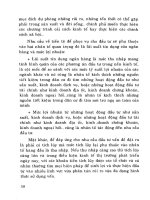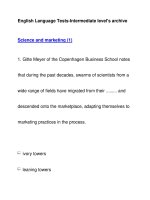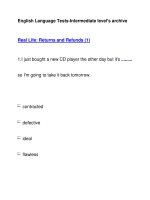final report: INTRODUCTION ABOUT COMPANY AND PRODUCTS
Bạn đang xem bản rút gọn của tài liệu. Xem và tải ngay bản đầy đủ của tài liệu tại đây (460.86 KB, 12 trang )
RAINBOW
Họ và tên MSSV
1.Võ Thị Nhật Bình K134080939
2.Nguyễn Thị Thanh Kim Huệ K134080956
3.Nguyễn Thị Kiều Huy K134080958
4.Huỳnh Thiên Phú K134080990
5.Nguyễn Ngọc Đan Quỳnh K134080991
Giảng viên: Phạm Tố Mai
Thành phố Hồ Chí Minh, ngày 24 tháng 4 năm 2015
I. INTRODUCTION ABOUT COMPANY AND PRODUCTS
1. COCO Company:
1
FINAL REPORT
RAINBOW
COCO Company was established on 1/1/2015.
Office: Nguyen Tat Thanh street, 4 dictrist, Ho Chi Minh City.
Website: www.Cocovina.com.vn .
2. Product
The company COCO specializes in manufacturing and exporting coconut oil was
established.
3. Reasons for choosing Korea.
Korea is known as land of beauty technology and care beauty - the best in Asia.
Comestic companies develop so strong and has a lot of famous brands in the world
market. Gradually, use of these products come from nature in beauty care is also being
focused.
• Geographic: South Korea is a country in temperate zone, it has the quite cold
climate, so that Korea can’t plant coconut trees which develop in hot and humid
conditions.
• Economy: South Korea is quite potential market for the export of Vietnam. In
2014, Vietnam exported large amount of goods to South Koreaa (7.11 billion US
2
RAINBOW
dollars of goods, almost are raw materials and textiles) and this number is
growing. This proves that there is a good economic relation, the Korean market is
relatively easy for Vietnam goods.
• Culture, Politics: The culture of Korea has much similarities with Vietnam. The
relationship of the two countries is developing, economic cooperation between the
two countries is constantly increasing over the years, governments and enterprises
Korea try to facilitate cooperation and development with enterprises of Vietnam,
this is a good opportunity for Vietnam enterprises to cooperate with domestic
enterprises to learn and share.
• Technology: Korea is considered cosmetic powerhouse. Beauty industry of Korea
is the top of the world with all kinds of natural products that are produced by
modern technology, so the market of raw materials for cosmetics production is an
opportunity, a great bait for Vietnam enterprises to take advantage.
In 2014, this is the time development of the oil exporters. The coconut oil import
markets such as US, EU… South Korea which 5th of coconut oil imports to
60,000 tonnes - 2014.
Coconut oil is a natural material with a lot of use. Not only is a vegetable oil to
feed, it also uses a very effective beauty. That is now a matter of beauty is a human
tendency. Not only including 47,630 tonnes of crude palm oil, 38,136 tons of oil
and 1,165 tons of oil and RBD cochin, total exports reached US $ 116.398 million
women but men have.
Korean cosmetics market is very large. However, most cosmetics are produced by
the chemical. So in the long run will not be good for the skin. Thus coconut oil is a
natural beauty products for skin looks great.
The Korean beauty and health-care industry looks back on years of constant
growth, both in terms of exports and imports, as well as total market size and
diversification of available products and services.
3
RAINBOW
4. Advantages of coconut development in Viet Nam.
Advantages of natural condition: Coconut is suitable for the weather and land of our
country, can be widely grown in the countryside, around the ponds, small irrigation
canal. It grow fast on sandy soil area, and it’s fond of wetland.
Advantages of workforce, cost of production: Plant coconut has advantage of saving
the time on take care of the grown, so the farmers still have free time to do others
housework.Viet Nam has abundant labor resources, cheap labor cost. Take advantage
of farmer’s free time and surplus labor in rural area.
Advantages of level of supply: Coconut brings great value more 1000 utilities from
copra and coconut juice. In Viet Nam, coconut area is only 4,2% coconut area of
Indonesia, 4,5% of Philippines, 40,5% of Sri Lanka. However, average productivity
has 9,863 trái/ha/năm, approximately 1,9 ton copra/ha, higher than average
productivity of APCC (0,9 ton copra/ha), Indonesia (0,85 ton/ha), India (1,1 ton/ha).
Ben Tre province has the biggest coconut area in Viet Nam, accouting for 40% of the
coconut area in Viet Nam, Ben Tre coconut has many kinds of good quality and high
productivity such as: native coconut, Dau coconut, Xiem coconut, Dua coconut.
II. OVERVIEW OF KOREA MARKET
1. The economic – geographic environment
a) Natural conditions
4
RAINBOW
Geography of Korea The rugged Central Mountains cover much of central and eastern
South Korea. They include the Sobaek Mountains and the southern half of the
T'aebaek Mountains.
The western and southern coasts of South Korea are dotted with some 3,000 islands,
most of them unpopulated. Natural Resources of Korea South Korea is relatively poor
in natural resources.
Korea's climate is regarded as a continental climate from a temperate standpoint and a
monsoonal climate from a precipitation standpoint. The climate of Korea is
characterized by four distinct seasons: spring, summer, fall, and winter. The wet
monsoon/summer season in the middle of the year, and a cold winter from November
to March. Winters are cold and dry. The summer months are muggy and hot. The
island of Jeju off the southern coast is the warmest and wettest place in the country.
Jeju is one of some islands which has coconut trees, however they are only planted for
tourism purpose not for sell. So that, Korea can’t produce coconut oil for their
industrial purpose. We won’t have rivals from Korea.
b) The economic environment and infrastructure.
In 2014, this is the time development of the oil exporters. The coconut oil import
markets such as US, EU… South Korea which 5th of coconut oil imports to 60,000
tonnes - 2014.
The Korean beauty and health-care industry looks back on years of constant growth,
both in terms of exports and imports, as well as total market size and diversification of
available products and services. It is worth to take note that nowadays not just Korean
women are spending high on such products but also men purchase cosmetics on their
daily routine. Experts estimate that Korea has become the largest market for men’s
cosmetics on a global scale.
5
RAINBOW
According to data released by the Korean Statistics Office, an annual average increase
of more than 10% in total market value of the domestic cosmetics industry was
recorded over the last five years. Even during turbulent times after the global financial
crisis, the industry showed its recession-resistance by growing approximately 11%.
Also in terms of total value of foreign cosmetic products imported to Korea, a steady
growth was recorded. In 2008, the total amount of imported items was equal to USD
860 million. The number then increased by more than 30% to USD 1’239 million by
the end of 2012. A further growth forecast, with an expected rise of CAGR 2-3% until
2015 is prospected due to the rising popularity of products based on natural, organic
and herbal ingredients. The domestic skincare market skyrocketed during the General
skin care products take the lion’s share by over 50% of all sales in the Korean
cosmetics market and can also be determined as the major market driver in the
upcoming years. The domestic skincare market skyrocketed during the period 2005-
2011 by showing a growth rates of 58%, mainly driven by facial care products.
Development: Cosmetic Industry Korea
Unit: 1’000 USD
Date: November, 2013
Author: Swiss Business Hub Korea
Author’s address: Embassy of Switzerland
77 ongwol-gil, Jongro-Gu
2. The political-legal environment
Government regulations:
6
RAINBOW
Korean Constitutional system focuses on mechanisms president is directly elected for a
term of five years . All decisions are made through the country's National Assembly,
including policies related to international business activities.
Taxes:
Korea has a flat 10 percent Value Added Tax on all imports and domestically
manufactured goods. A special excise tax of 10-20 percent is also levied on the import of
certain luxury items and durable consumer goods. Tariffs and taxes must be paid in
Korean Won within 15 days after goods have cleared Customs.
Formal trade barriers:
For companies exporting to the Republic of Korea, the following shipping documents are
required to clear Korean Customs:
- Commercial Invoice: An original invoice and two copies must be presented with the
shipping documents and must include total value, unit value, quantity, marks, product
description and shipping from/to information.
- Certificate of Origin: Prior to implementation of the KORUS FTA, a Certificate of
Origin, in duplicate, was required for some products.
Self-certification of origin by the producer or exporter is normally the basis for deciding
that the good qualifies for preferential tariff rates.
If the certification is in English, an official translation into Korean must be presented by
the importer to Korean Customs. A certification may be made for a single shipment or for
multiple shipments of identical goods, for up to twelve months. The certification
including at least the following information:
a) Name and contact information for the certifying person
b) The importer, The exporter, The producer of the good.
c) Tariff classification and description of the good
d) Information demonstrating that the good originates from the United States.
7
RAINBOW
e) The producer’s written or electronic certification that the product meets KORUS
FTA origin requirements.
f) Date of the certification.
g) In the case of a blanket certification, the cover is nescessary.
Intellectual property rights and regulations:
Intellectual property laws exist in Korea.
Viet Nam companies wishing to sell their products or services in Korea should first and
foremost find out if they have to register their intellectual property rights (copyright,
trademark or patents) in Korea. The speediest means to enforce the right-holder’s claim is
to have their intellectual property recognized by the Korean authorities and government.
Recommend actions that might be necessary for an existing company or a
new enterprise with regard to factors in the political and legal environment.
Trade Barrier
Improving quality of products in order to meet rigorous standard of Korea’s market.
Recruiting, training, hiring experts to analyst and negotiate about international business;
legal, procedure consultant for company.
Tariff: Pricing by adding Value Added Tax appropriately to evade from allegations of
Korea’s government that says our company have sold tax, dumped tax.
Intellectual property laws:
Designing package, trademark, brand,….must appropriate to Korea culture. Then
registering intellectual property in Korea about brand, package, before penetrating
Korea’s market offically.
3. The social- cultural environment
a) An overview of demographic trends that could influence global business
activities.
South Korea’s birthrate last year fell to the lowest level on record and South Koreans
could face natural extinction by 2750.
8
RAINBOW
Just 8.6 babies per 1,000 South Koreans were born last year, the lowest level since the
country began keeping records in 1970, the national statistics agency said.
Age structure: 0-14 years: 14.1% (male 3,603,943/female 3,328,634)
15-24 years: 13.5% (male 3,515,271/female 3,113,257)
25-54 years: 47.3% (male 11,814,872/female 11,360,962)
55-64 years: 12.4% (male 3,012,051/female 3,081,480)
65 years and over: 12.7% (male 2,570,433/female 3,639,083) (2014 est.)
Source: CIA World Factbook - Unless otherwise noted, information in this page is
accurate as of August 23, 2014
Proportion of young people use more than cosmetic
b) A description of cultural factors, social institutions, and informal trade
barriers that could affect global business activities.
South Korea is a country so focused on being beautiful. To many, being beautiful on
the same standard means that life will be easier and they will have a higher chance of
getting a better job.
In the field of cosmetics, Koreans can’t stop experiment with new ingredients and
methods. They create snail cream (creams made from snail gut) in 2011. Also, they make
9
RAINBOW
nail polish which is mixed with real flower petals. And not only women who love beauty
products, men in South Korea also attaches to the use of cosmetics. Currently, South
Korea is the world's largest market in cosmetics for men.
Negotiations Business in Korea:
Korean partners often build general agreement then start discuss in detail the
necessary issues. They only accept the terms and conditions clearly. Contracts are often
long with details including terms and conditions of an ordinary partnership agreement as
well as the force majeure clause. However, the drafting and signing of the contract must
comply with the procedures. Koreans believe that the most effective of a partnership
agreement depends on the commitment of the parties rather than what is stipulated in the
contract. Although the lawyer is only used and respected a little in Korea, the advice of
expert legal before signing a contract is necessary. However, you have to be careful when
they go to the negotiating table, some Korean partners may consider this an act of mutual
distrust partners may consider this an act of mutual distrust.
c) Recommend actions for existing companies
Creative Cosmetics is one of the unique culture of Korea, especially for women, and
enterprise socializing in the production cosmetics. With products from coconut, Coconut
company should introduce the simple method for processing many types of hair and skin
care cosmetics naturally and conveniently at home.
Besides, Korean firms are also very fastidious to cooperate, so to brand Coconut can
stand on the market, Coconut should be noted: Koreans are very seriously
"individualism" therefore, building lasting and reliable personal relationships is very
important in the collaborative process.
Mentioning benefits in the long-term regularly and your commitment to building
collaborative relationships with partners.
10
RAINBOW
Before signing the contract with Korean businesses, enterprises Vietnam should be
forcible and careful about the contract terms, especially the terms of payment. Pay
attention to food safety and quality of products which is should be tested and certified
safe by the authorities
When there is any problem or seeing your partners have some signs of non-
cooperation, you should carry out the necessary procedures with the authorities in both of
countries soon.
III. Business strategy
1. Production:
Ben Tre is more advantage of area, yield and technology than other provinces, so Ben Tre
is the first proposal for the supply materials of coconut oil export.
The company will build a processing factory with full function from split coconut to
packaging, especially near to the source material to saving cost. Then, we’ll buy crude
coconut from farmers, transport to factory to processing and packaging. Manufactured
under traditional process and must meet the requirements on food safety, aims to reach
international GMP standard.
2. Sales:
Korean attaches great importance product quality more than price, so strategy will be
applied here is differentiation, not low cost. In promoting products, we should focus on
the completely natural aspects of product and the convenience, easy to use.
Products will be contained in vial with a suitable volume: 50ml, 100ml, 250ml for
individual users and bins 10l, 15l for the hair salon.
3. Distribution:
First step, with target market is Seoul city, we’ll cooperation with the distribution
company, who distributing cargo (including cosmetics) or only beauty product to retail
consumers and salon. In long-term, we will have a plan for self-distribution.
4. Competitors:
11
RAINBOW
Nowadays, coconut and coconut products are exported to many countries, turnover of
coconut oil continue increases rapidly; especially, the product in beauty industry. Coconut
oil is competitive and prospective on developing in the future, so there’re many potential
competitors focusing on that business. The most coconut exporting is Indonesia,
following by the Philippines, India. Vietnam’s sales is lower than those countries. On the
other hand, there’re no activities of Oil Tree Research Institute (including coconut
researching); the government also have no specific political for coconut. Therefore,
comparing to competitor in other countries, the competitiveness of Vietnamese company
is weak.
12









